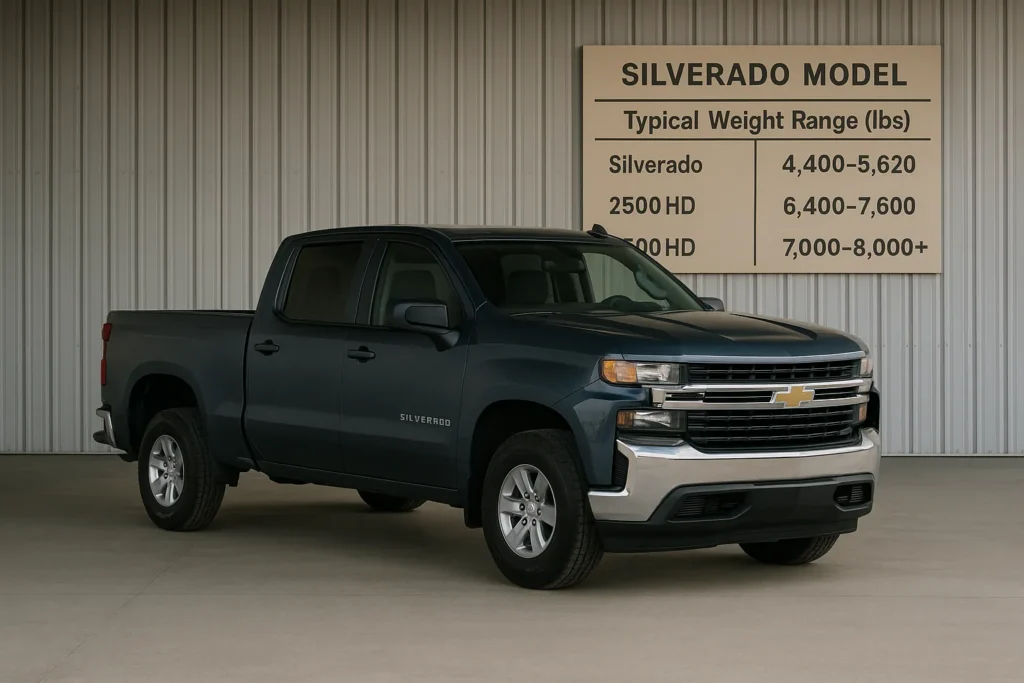If you’ve ever stood next to a Chevy Silverado, you know it’s not a small truck. It’s big, solid, and built to handle serious work. But here’s the question that gets asked all the time: how much does a Chevy Silverado actually weigh?
The answer isn’t just one number. It depends on the model, the cab size, the drivetrain, the engine, and even the year you’re looking at. And here’s the thing — that weight isn’t just a spec on paper. It directly affects how the truck drives, how much you can tow, how much fuel it drinks, and even how safe it feels on the road.
So let’s break this down in a way that feels like you and I are sitting in the garage, talking trucks. By the end, you’ll know exactly what to expect from the Silverado’s weight and why it matters so much if you’re planning to buy one or compare it with another truck.
Snippet-Ready Explanation:
A Chevy Silverado typically weighs between 4,400 and 7,600 pounds, depending on the model (1500, 2500, or 3500), cab style, drivetrain, and engine type. Its weight directly affects towing, payload, and fuel economy.
Understanding Truck Weight Basics
Before we dive into the Silverado numbers, let’s clear up some weight terms that can be confusing.
Curb weight is simply how much the truck weighs when it’s sitting there with all standard equipment, a full tank of gas, but no passengers or cargo. Think of it as the truck’s “empty” weight.
Gross Vehicle Weight Rating (GVWR) is different. It’s the maximum total weight your truck is allowed to handle safely — that includes the truck itself, passengers, cargo, and even the trailer tongue weight. Exceeding this can cause safety issues, wear out your brakes, and might even void warranties.
Then there’s payload capacity, which is how much extra weight (people, gear, tools, stuff in the bed) the truck can carry. Towing is another number, but that’s more about what the truck can pull behind it. All of these depend on — you guessed it — the actual weight of the truck.
And just so you don’t have to grab a calculator, one ton equals 2,000 pounds. So when we talk about a Silverado weighing around 4,500 pounds, that’s just over two tons.
Chevy Silverado Weight by Model and Year
Now for the numbers you came here for. The Chevy Silverado lineup comes in three main flavors: the light-duty 1500, the heavy-duty 2500HD, and the even beefier 3500HD. Each one has its own weight range.
Silverado 1500
This is the “everyday” Silverado most people drive. Its weight can range from about 4,400 to 5,620 pounds depending on cab style and drivetrain.
- Regular Cab: 4,400–5,100 lbs
- Double Cab: 4,750–5,300 lbs
- Crew Cab: 4,900–5,620 lbs
So if you’re wondering how much a Chevy Silverado 1500 crew cab weighs, it’s usually right around 5,000–5,600 pounds.
The gross vehicle weight (GVWR) for the 1500 typically lands between 6,800 and 7,100 pounds depending on options.
Silverado 2500HD
Here’s where the weight jumps. The Silverado 2500HD ranges from about 6,400 to 7,600 pounds. That’s three tons or more.
- 2WD Gas: ~6,421 lbs
- 2WD Diesel: ~7,272 lbs
- 4WD Gas: ~6,736 lbs
- 4WD Diesel: ~7,587 lbs
If you ever hear someone ask about the weight of a Silverado 2500 in tons, it usually sits between 3.2 and 3.8 tons.
Silverado 3500HD
This is the heavy hitter. The Silverado 3500 is built for serious towing and hauling, so naturally, it’s the heaviest. Depending on the configuration, you’re looking at weights that push well past 7,000 pounds. Fully loaded dually models can creep close to 8,000 pounds.
By Year
The Silverado has evolved, and so has its weight.
- 2005 Silverado: Around 4,600–6,000 lbs depending on trim
- 2014 Silverado: About 4,800–5,700 lbs
- 2016 Silverado: Roughly 4,900–6,000 lbs
- 2022 Silverado: 4,400–7,600 lbs across trims
- 2023 Silverado 1500: Crew cab models typically around 5,000–5,400 lbs
Each new generation uses stronger materials, different engines, and new safety features that shift the weight a little.
What Affects the Silverado’s Weight?
So why do the numbers vary so much? Here are the biggest factors.
- Cab size: Regular cabs are the lightest, crew cabs are the heaviest. More doors and more space mean more weight.
- Bed length: A long bed adds more steel and structure, which adds pounds.
- Drivetrain: A 4WD system is heavier than 2WD, thanks to extra components like transfer cases and differentials.
- Engine: A V8 or diesel engine weighs more than a V6 gas motor. Diesel, in particular, adds hundreds of pounds.
- Trim levels: A basic work truck is lighter than a luxury High Country trim with leather seats, big wheels, and tech features.
- Add-ons: Off-road suspension, skid plates, winches, and aftermarket gear like toolboxes and lift kits add up fast.
I once added a steel toolbox and bigger tires to a Silverado 1500 I owned, and the difference in handling was noticeable. It felt more planted, but it also drank more gas.
Why Silverado Weight Differences Matter
Here’s the part a lot of folks overlook: weight isn’t just a stat for bragging rights. It actually affects your everyday driving.
- Fuel economy: Heavier trucks use more gas, plain and simple. If you’re commuting daily, that extra 500 pounds can make a difference at the pump.
- Towing and payload: The heavier the truck itself, the less it can technically carry in payload because the GVWR is fixed. So sometimes, lighter trims actually let you haul more.
- Handling and safety: A heavier Silverado feels more stable on the highway, especially when towing. But it also takes longer to stop, and brakes wear faster.
- Long-term maintenance: More weight equals more strain on suspension parts, tires, and brakes.
It’s a balancing act. If you want luxury and power, expect extra weight. If you want efficiency, stick to a lighter build.
How to Find the Exact Weight of Your Silverado
If you own or are about to buy a Silverado, there are easy ways to find its exact weight.
- Door jamb sticker: Open the driver’s door and look for the manufacturer’s sticker. It lists curb weight and GVWR.
- Owner’s manual: It’ll usually have weight specs by trim.
- VIN lookup tools: Plugging your VIN into online databases often gives you the exact curb weight for your build.
- Public scales: Many truck stops or recycling centers have certified scales. If you want a 100 percent accurate number, drive on and check.
Tip: weigh it with a full tank and note if you’ve added aftermarket gear. That changes the numbers.
Expert Insights and Lesser-Known Details
One thing I love about the newer Silverado generations is their use of mixed materials. Chevrolet uses high-strength steel where it matters and lighter aluminum in other areas. This keeps the weight reasonable while still maintaining durability.
Also, if you’re into off-roading, know that trims like the Silverado ZR2 or Trail Boss add extra weight. The beefier shocks, skid plates, and off-road tires don’t come light.
Here’s something else: regional differences. In colder climates, people often add winter gear like plows or heavy-duty tires. That can add hundreds of pounds. In farming regions, you’ll see tool racks, trailers, and gear permanently mounted.
How Silverado Weight Compares With Other Trucks
Against its main rivals, the Silverado is right in the middle.
- Ford F-150: Typically lighter in its base trims thanks to more aluminum use.
- Ram 1500: Similar to Silverado, often within a couple hundred pounds.
- GMC Sierra: Nearly identical since it shares the same platform.
So if you’re cross-shopping, don’t expect Silverado to stand out dramatically in weight. It’s balanced for both everyday drivers and work users.
Future Outlook: Silverado Weight Trends
Looking ahead, the Silverado EV is about to change the game. Electric trucks are heavier because of massive battery packs. Expect the Silverado EV to push well past 8,000 pounds.
Chevy is also exploring more lightweight materials to offset this. Hybrid and plug-in options might help balance weight with efficiency in future models.
Quick Comparison Table
| Silverado Model | Typical Weight Range (lbs) | Weight in Tons | Notes |
| Silverado 1500 | 4,400 – 5,620 | 2.2 – 2.8 | Everyday light-duty truck |
| Silverado 2500HD | 6,400 – 7,600 | 3.2 – 3.8 | Heavy-duty work truck |
| Silverado 3500HD | 7,000 – 8,000+ | 3.5 – 4.0+ | Max towing & hauling power |
Bullet List: How to Check Your Silverado’s Exact Weight
- Open the driver’s door and check the manufacturer’s sticker for curb weight and GVWR.
- Look in the owner’s manual for model-specific numbers.
- Use a VIN lookup tool online for your exact trim weight.
- Visit a public scale (truck stop, recycling center) for the most accurate number.
Frequently Asked Questions
How much does a Chevy Silverado weigh in tons?
Between 2.2 and almost 4 tons depending on the model.
What is the weight of a Chevy Silverado 2500?
Anywhere from 6,400 to 7,600 pounds depending on drivetrain and engine.
What is the weight of a Chevy Silverado 3500?
Closer to 7,000–8,000 pounds.
How much does a Chevy Silverado 1500 weigh?
4,400 to 5,620 pounds.
How much does a 2023 Silverado 1500 Crew Cab weigh?
About 5,000–5,400 pounds depending on trim.
What is the gross weight of a Silverado?
Ranges from 6,800 to over 11,000 pounds depending on the model.
How much does a 2005 Silverado weigh?
Roughly 4,600–6,000 pounds.
How much does a 2014 Silverado weigh?
Around 4,800–5,700 pounds.
How much does a 2016 Silverado weigh?
About 4,900–6,000 pounds.
How much does a 2022 Silverado weigh?
Anywhere between 4,400 and 7,600 pounds.
Conclusion
So, how much does a Chevy Silverado weigh? The short answer: anywhere from about 4,400 pounds for a light-duty 1500 all the way up to nearly 8,000 pounds for a fully loaded 3500HD. The exact number depends on cab size, drivetrain, year, and trim.
But the real takeaway is that Silverado weight isn’t just a number. It shapes how the truck feels to drive, how much it can tow, and how dependable it feels when you’re out on the road.
I remember the first time I drove a Silverado — that solid, planted feel came from its weight. It’s what gives you confidence when you’re pulling a trailer or cruising down the highway in bad weather.
If you’re eyeing a Silverado, trust me — its weight isn’t a drawback. It’s part of what makes it one of the most dependable trucks on the market.
Disclaimer:
All weight figures are based on manufacturer data and typical model ranges. Actual weight may vary depending on year, trim, modifications, and added equipment. Always verify your specific Silverado’s weight through official Chevy documentation or certified scales before towing or hauling.

Hi, I’m Bilal, the founder of outofmagazine.com. I love sharing fresh ideas, stories, and helpful insights on all kinds of topics that spark curiosity. My goal with this site is simple—to create a space where readers can find inspiration, useful tips, and engaging reads on lifestyle, trends, and everything in between.



